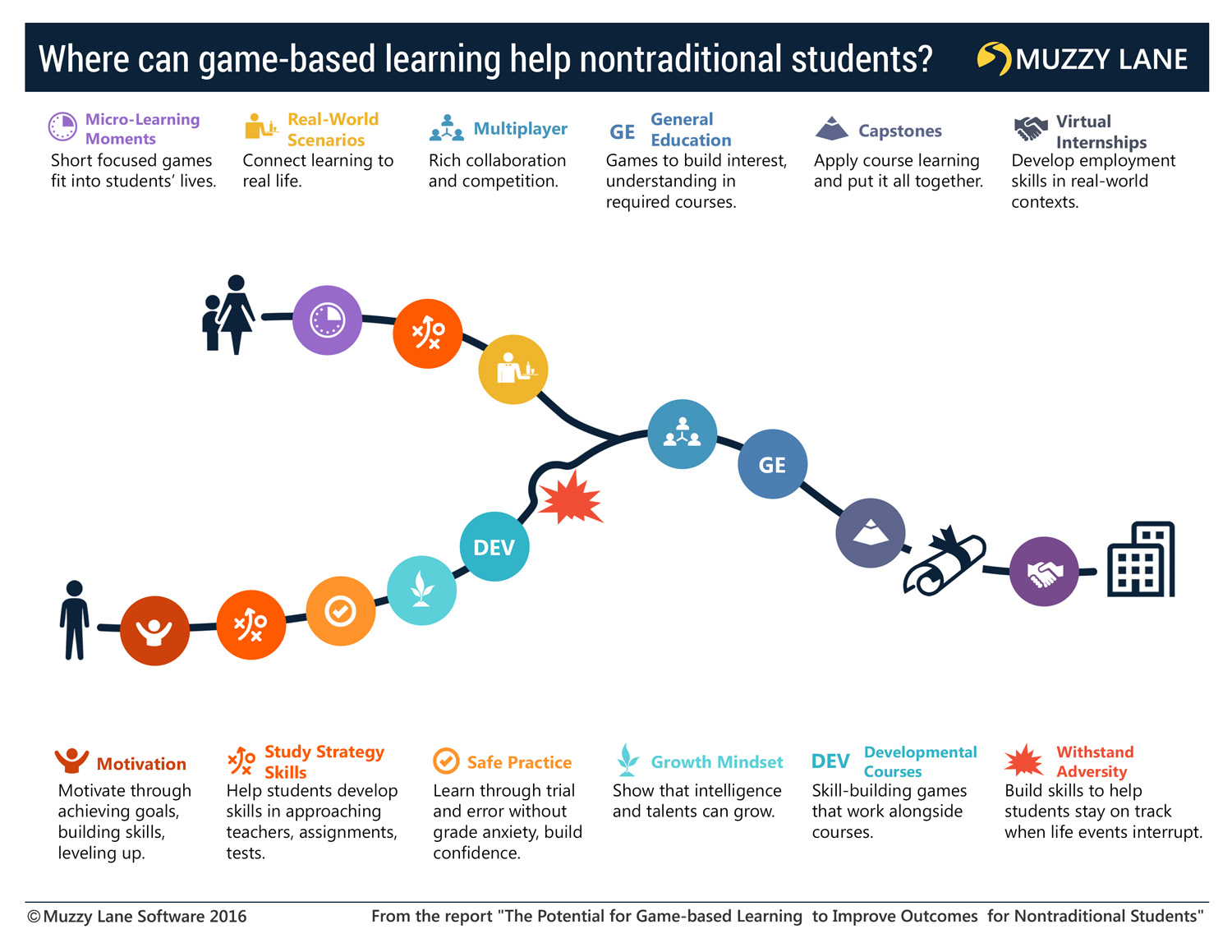Gates Research
Journey Map showing where in the student journey GBL has the potential for impact.
How can game-based learning help nontraditional students in higher ed?
Bert Snow is the author of the research report How Game-based Learning can help improve Outcomes for Nontraditional Students in Higher Education. This research was funded by the Bill and Melinda Gates foundation.
To investigate the question, Bert and a team at Muzzy Lane conducted focus groups and an online survey with nontraditional students and interviewed school leaders and educators at community colleges and four-year institutions that serve them. The team also created prototypes of concepts inspired by the research and reviewed those prototypes with educators. Bert comments on the research below. The full report can be found here.
In the focus groups, we met students who are dedicated and hardworking, but also must balance school with work and family, making them vulnerable; one family emergency can knock them off track.
We found that nontraditional students are taking more online classes than other students, with those working more than 30 hours taking the most. They appreciated the flexibility that online courses provide, but worried that they might not be developing the skills they would really need for jobs and certifications. They also asked for apps that fit their lives, work on their devices, make good use of their time, and could give them great feedback even at two in the morning.
There is a clear opportunity to help these students through improved digital materials, and game-based learning can be an important tool in this work. Research and meta-studies we reviewed support its effectiveness when design best practices are used. In our interviews, educators suggested many specific applications, which are detailed in this report. Five that stood out are:
Auto-assessing whether students can apply what they have learned
Building employment skills in real-world contexts
Providing safe environments where students can learn through trial and error
Developing and assessing critical thinking skills
Study-strategy and student-success skills
However, our interviews with Higher Education leaders (and our own experience) also show clearly that there are hurdles: Issues of cost, curriculum fit, usability, and control have limited the use and impact of game-based approaches. Most Game-Based Learning projects to date have been high-cost custom-development projects that many schools simply cannot afford. Upkeep is also expensive, as the development studio usually must be brought back to make changes. To explore ways to clear these and other hurdles, we developed concepts and prototypes and reviewed our work with educators and school leaders. This work yielded several promising directions:
Make game-based learning authorable and inexpensive, rather than custom-built and high-cost. Enabling educators to author and maintain game-based learning resources can greatly reduce initial and ongoing costs. It also will tap into teachers’ creativity and enable instructional designers and others to build game-based learning to meet needs of specific student population, and to fit with their systems We believe authoring will unlock tremendous growth in the field.
Fit flexibly into existing curriculums and students’ lives. Educators did not ask for big, disruptive game-based courses. They were looking for ways to meet students’ needs, and saw many places where shorter, more flexible “learning moments” could help - IF they were easy for students and faculty to start and use.
Work intuitively on all devices, including phones. Digital materials need to work everywhere, and students increasingly like to be able to study on their phones as screens get larger – especially if they can use engaging activities or games that they can pick up for a few minutes at a time.


